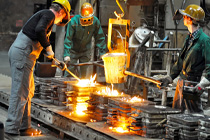Nov . 15, 2024 17:09 Back to list
spring rod
The Spring Rod A Key Component in Mechanical Engineering
In the realm of mechanical engineering, various components play pivotal roles in the functionality and efficiency of machines. Among these components, the spring rod stands out as an essential element often overlooked in discussions about mechanical design. With its unique properties and wide range of applications, the spring rod is not only vital for the performance of various systems but also represents a fascinating intersection of physics and engineering.
Understanding the Spring Rod
A spring rod is a cylindrical metal component, typically made from high-strength materials such as steel or composite alloys. Its design allows it to withstand significant stress while providing flexibility and resilience. The primary characteristic of a spring rod is its ability to return to its original shape after being deformed under an external force, which makes it an ideal candidate for applications that require energy absorption and release.
The spring rod operates based on Hooke's Law, which states that the force exerted by a spring is directly proportional to its displacement, provided the material remains within its elastic limit. This property enables engineers to calculate how much force a spring rod can exert or how much it can compress under load, which is crucial for designing systems that rely on precise mechanical actions.
Applications of Spring Rods
Spring rods are used in a multitude of applications across various industries. One of the most common uses is in automotive suspension systems. Here, they absorb shocks and vibrations from the road, providing a smoother ride for passengers. The spring rod allows vehicles to maintain stability while accommodating uneven surfaces, making it an integral part of vehicle design.
In the aerospace sector, spring rods are employed in various mechanisms, ranging from landing gear to control systems. Their lightweight and robust nature makes them suitable for high-performance applications where weight can significantly impact overall efficiency and safety. The ability to manage and dissipate energy is crucial in aerospace engineering, where every gram counts.
spring rod

Another significant application of spring rods is in the field of manufacturing and automation. Machines that require movement or force application often utilize spring rods to ensure precision and reliability. Whether it’s in conveyor systems, robotic arms, or CNC machinery, spring rods enable these systems to function smoothly and efficiently. They help maintain tension and keep components in the right position, ensuring that processes run without interruption.
The Advantages of Spring Rods
The benefits of incorporating spring rods into mechanical designs are manifold. First and foremost, their ability to absorb and dissipate energy allows for smooth operation of moving parts. This is vital in reducing wear and tear on components, ultimately extending the lifespan of machinery and reducing maintenance costs.
Moreover, spring rods provide considerable design flexibility. Engineers can customize the tension and compression characteristics by adjusting the material properties and dimensions of the rod, tailoring it to specific applications. This versatility makes them an invaluable resource in custom machinery design, where standard parts may not suffice.
Additionally, spring rods are often cost-effective solutions for engineers. Their widespread availability and relatively simple manufacturing processes mean that they can be produced at scale without incurring significant costs. This economic advantage is especially important in sectors that aim to minimize production costs while maximizing efficiency.
Conclusion
In summary, the spring rod is a vital component within the landscape of mechanical engineering, serving essential functions in various applications from automotive systems to aerospace and manufacturing. Its unique properties—flexibility, energy absorption, and cost-effectiveness—make it a preferred choice among engineers seeking to enhance the performance and reliability of their designs. As technology continues to evolve, the importance of spring rods will only grow, affirming their role as indispensable elements in the advancement of engineering innovation. In a world that increasingly relies on sophisticated machinery, the humble spring rod stands tall as a testament to the brilliance of simple yet effective design.
-
Eco-Friendly Granule Covering Agent | Dust & Caking Control
NewsAug.06,2025
-
Fe-C Composite Pellets for BOF: High-Efficiency & Cost-Saving
NewsAug.05,2025
-
Premium Tundish Covering Agents Exporters | High Purity
NewsAug.04,2025
-
Fe-C Composite Pellets for BOF | Efficient & Economical
NewsAug.03,2025
-
Top Tundish Covering Agent Exporters | Premium Quality Solutions
NewsAug.02,2025
-
First Bauxite Exporters | AI-Optimized Supply
NewsAug.01,2025
